« Best of JM: Thin-slicing and Music Theory |
Main
| Best of JM: Building off silence »
 April 25, 2013 | Easy Transposition April 25, 2013 | Easy Transposition
You can stretch the ears (and fingers) of a folk musician when you introduce "new" chords like DMaj7 or Em7. They will be use to D triads and G, A7, too. Of course every time a new chord comes up like this, it takes some research, likely in the form of a chord book or online chord encyclopedia. It's easy for them to be lazy though, since bluegrass tends to stay around the open string chord keys of G, D, and A, maybe a venture into C or B, and rarely do you inject more than a Dominant 7th chord.
Jazz is an exponentially more complex harmonic venture. Throw the concept of a DbMaj7 out there, brain and fingers freeze. Even someone with a moderate amount of music theory is easily intimidated by the notion of a key with 5 flats, but when you're equipped with transposition skills, the world is your oyster. You change from having to look up every single chord in the Great American Songbook and learning them block by block to learning the most common ones, and building a vocabulary based on chord relationships.
In some ways, knowing music theory is cheating.
Take that DbMaj7 chord. You can know it, learn to transpose it 11 more times, and you have 12 different blocks. Still, that seems like a lot, anything times 12. With some easy transposition skills, you can reduce the brain circuitry to much better efficiency.
Let's step back and take a look at one of the chord blocks we've introduced in the first block of our 3-Note Playing Cards, the 'ii V7 I' block:
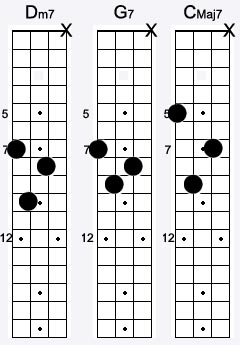
First thing we can do is move it up two frets. Instead of 'Dm7 G7 CMaj7' you have 'Em7 A7 DMaj7'. Note, you didn't learn three new individual chords, you just learned the transposition of three you already knew.
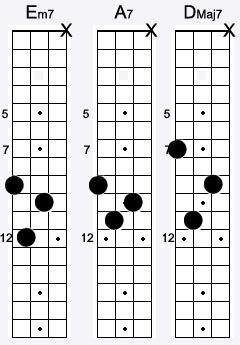
Same thing moving the blocks down two frets, we learn three new chords, not individually, but as a transposition of familiar, now you find yourself playing in a spooky flat key, Bb Major. Your bluegrass friends are impressed, but all you did was move your fingers a few frets lower.

Take the keys in between, and you've learned the basic 'ii V7 I' sentence of some more chromatically intimidating keys, BMaj7 (also enharmonically spelled CbMaj7, by the way) and DbMaj7

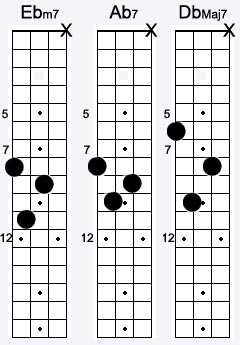
About that DbMaj7. Remember how we said that was a scary key to the folk musician, you just arrived there, as well as learned 15 more chords, simply by moving around the first two you learned from our Playing Card. Take into account there are only 12 keys, you've just now mastered in this short time, the capability of playing HALF of all of them.
This is probably obvious to the veteran jazz player, but it illustrates how much a little bit of theory multiplies fretboard facility. Hopefully, you're getting to the point where you don't even need to look at a chord reference again.
Of course, you can only transpose these so far before you run out of reasonable fingerboard real estate. That's why it's important to learn a few more blocks of the 'ii V7 I', to voice the other six keys, and develop some better voice leading in songs. Take some time to move them around, too.
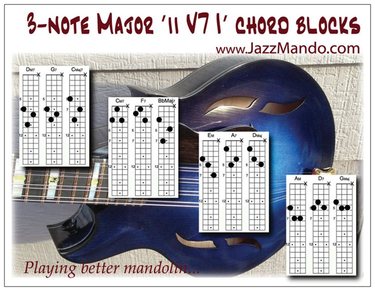
Purchase the whole set: 3-Note Playing Cards
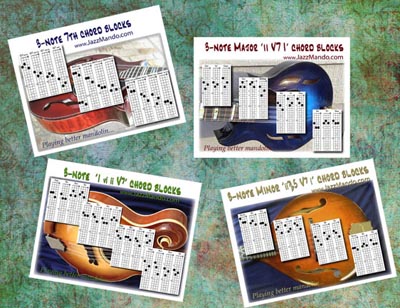
Further
Mobility--chord transit
Major 'ii7 V7 I' 3-note Mandolin Chord Blocks
Tasty Major landing chords
7th Chord Streams. Under the hood.
I hate music theory (Part 1)
Posted by Ted at April 25, 2013 9:11 AM

Disclaimer: In the 'Information Age' of the 21st Century,
any fool with a computer, a modem, and an idea can
become a self-professed 'expert." This site does not
come equipped with 'discernment.'
|



